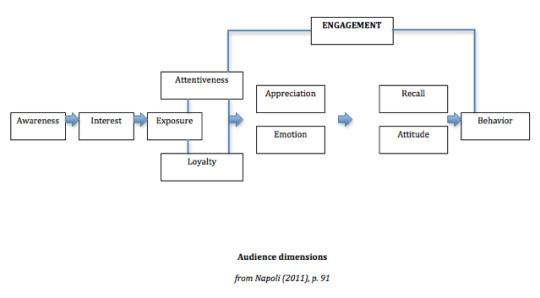Link
"I have always been fascinated that humans interact online when we can interact offline as we have for thousands of years," says Piskorski, an associate professor in the Strategy unit at Harvard Business School. "We used to have friends without Facebook, or Twitter, and we used to find spouses without dating sites, and nobody ever complained. This begs a very basic question—what kinds of interaction does the online world give us that we cannot undertake offline?"
1 note
·
View note
Photo

Defining engagement, via Jonathan Groves (who got it from Philip Napoli)
1 note
·
View note
Link
Human, bot, or something in between? We asked ABC News, the AP, CNN, NBC News, The New York Times, USA Today, and The Wall Street Journal how they power their Twitter and Facebook accounts.
super interesting.
0 notes
Quote
If the supposedly self-involved members of the creative class can organize to assert some control over what they make — the magical stuff now routinely referred to as “content” — then maybe other residents of the beleaguered middle might be inspired by their examples.
A.O. Scott
0 notes
Quote
"We take this work for granted now, but our home delivery and single-sales efforts represented one of the most sophisticated consumer-outreach operations in history. But when the time came to put our journalism on the web, we adopted a much more passive approach. We published stories on our home page and assumed that most people would come to us."
New York Times internal report, via buzzfeed
0 notes
Quote
"More than half of video ads are not seen."
New York Times
0 notes
Link
Next big thing:
At least 15 percent of the top 10,000 websites are conducting A/B tests at any given time, according to BuiltWith, an Australian company that scans sites to see what types of third-party software they are using. The not-for-profit Wikimedia Foundation, which publishes Wikipedia, tested various tweaks to its fund-raising messages throughout 2013, with results a spokesman calls “amazing.” The organization says the more effective its appeals are, the fewer of them it has to show.
0 notes
Quote
Any newsroom, new or old, has its issues, but a new, well chosen, well paid one can spend so much more time on the work and so much less time on the “change.”
Wise words from Ken Doctor at Nieman Lab
2 notes
·
View notes
Link
All my thoughts on the future of media, in one place (Medium!).
1 note
·
View note
Video
youtube
Not posting this because Eric Newton, the senior adviser to the president at the Knight Foundation (which funds a huge slice of the journalistic innovation happening now), mentions me—but rather because he emphasizes the importance of experimentation and user-centered design in journalism. YES!
0 notes
Link
The future of the media business continues to be an important and oftentimes confusing discussion. Here are a few thoughts.
great read by a smart guy.
0 notes
Quote
DFM’s Thunderdome may be closing its doors, but the trend toward centralizing content production and editing is a fundamental feature of the L.A. Register launch.
Nieman Lab
0 notes
Link
The senior vice president of strategy at News Corp has some ideas about how to determine how outlets are really managing the disruption of their businesses — and newsrooms.
0 notes
Link
This post digs into the BBC's tagging system as a means of informing (and maybe someday atomizing) news content.
h/t Tyson Evans
0 notes
Quote
Membership...is the measure of whether you have a passionate following.
Joel Kramer, CEO of MinnPost
1 note
·
View note
Text
Local takes another hit with the demise of Digital First Media's Thunderdome

Big news this morning: Digital First Media's Thunderdome Project, an experiment in introducing economies of scale to local news, is dead. (In the photo, DFM's Jim Brady talking to Knight Fellows last year.)
From Nieman Lab:
Today, we’ll hear official word of the demise of Project Thunderdome, one of the news industry’s highest-profile experiments in centralized, digital-first, mobile-friendly, new-news-partner content creation. Digital First Media CEO John Paton first announced the creation of what became a 50-plus person, New York City-based operation three years ago.
In the closing, and in other cuts at Digital First Media, we see the impact of unending high-single-digit loss in print advertising. The ongoing devastation in print is overwhelming even DFM’s relatively faster pace of digital innovation.
Where DFM went wrong, in my opinion, was its approach to centralized content. The value proposition of local is...well, being local. Content should be the last thing that companies try to replicate across disparate communities.
There's a lot of debate about whether local news can scale at all; I believe it can. But it will take serious focus on the aspects of news production that can and should be centralized (technology, national ad sales, etc.), while letting the locals run the parts—like content—that should always be local.
0 notes
